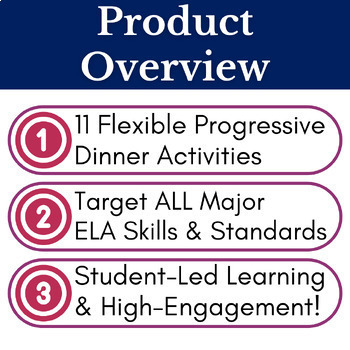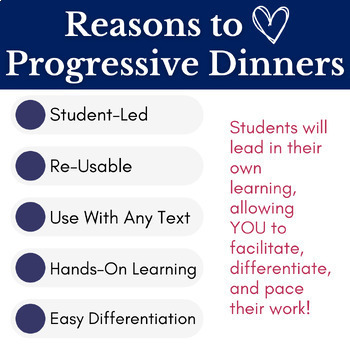Fun Reading Stations Activity BUNDLE - Fiction, Nonfiction, Poetry, Writing
- Zip
What educators are saying
Products in this Bundle (10)
showing 1-5 of 10 products
Description
Looking for high school reading comprehension passages and questions? Think outside the box with these interactive, engaging reading stations and writing stations activities! Students will read fiction, nonfiction, and poetry texts, engage in small group discussion, and revise any essay writing assignment, including expository, argumentative, literary analysis, and more! If you're looking for a structured way to practice critical close reading, writing, and revision skills in a hands-on and interactive way, this is the activity BUNDLE for you!
I use the popular reading stations close reading activity to have students select literary criticism articles for their analysis essay. There are seven different stations, each with an excerpt from a different literary criticism article. Students rotate from station-to-station, taking notes on a paper plate and rating each text. Before leaving for the day, they reflect on what they learned and let me know which criticism article they would like to focus on for their essay. You could also have students read thematically-connected poetry, engage in close reading of a complex fiction or nonfiction text, and engage in small group discussion. These are just some of the possibilities!
I use the revision stations writing activity to sustain focused revision of student writing, choosing from seven different revision checklist menus, including MLA format, sentence style, introduction and conclusion, paragraph writing, links (transitions, connections, quote blending), word choice, and thesis statements. You can choose the menus that fit the needs of your students to customize their dining experience. Just this week, I plan to use the word choice, introduction, and sentence style menus for station work as my students need to work on stylizing a multiple-perspective narrative piece. Even within one menu, there are plenty of options for students to focus on!
I use the critical lenses stations activity, to help students look at a text in new ways. This is a great activity to prepare students for AP Literature and college-level textual analysis. Choose from six different critical lens menus, including Reader Response, Feminist, New Historicism, Formalist, Psychoanalytic, and Marxist. Choose the menus that work best with the text you're studying (or customize your own) and set up 2, 3, 4, or 6 different station rotations.
I use the microfiction activity, to help students explore the style of micro fiction writing. There are 15 different text options to use at progressive dinner™ stations. Students rotate from station-to-station, taking notes on a paper plate or handout. Before leaving for the day, they reflect on what they learned and, if you wish to extend their learning, they can use the "writing" menu of options for written response to the text(s).
I use the slam poetry stations to introduce students to slam poetry, building listening and analysis skills. This works well as a unit intro or as an activity to help students find a slam poet or slam poetry style they enjoy.
I use the source evaluation stations during the research process to help students think about the credibility of an online source. Station menus prompt students to think about the credibility and quality of online texts.
I use the poetry analysis stations to build poetry analysis skills. This is a great way not to "kill" students' desire to explore and understand poetry with too much teacher-directed analysis. Menu prompts students to think about poem structure and style, and to make inferences. There is also a menu of writing options which you may choose to use as an extension.
The back-to-school icebreaker stations activity is a fun way to build classroom community at the beginning of the year. Students will meet, interact with, and take notes about their classmates and write affirmation notes. Then, they will participate in a personality sorter activity and help you to create a classroom poster that visually represents the diverse personalities in the room.
10 fun writing activities stations can be used to spark imagination for journal writing, creative writing, or any time you need to freshen-up English class for a day.
Rhetorical analysis stations give you 40 different texts (op-ed, open letter, commercial/psa, and speeches) for students to analyze and discuss. There is enough food-for-thought here to last you the whole semester (or more)!
Short story analysis stations are perfect to sort students into reading groups or to preview/review texts for a unit of study. I've linked to 27 different short stories of varying lengths that can be found online, including "classic" short stories as well as contemporary ones that you may not have heard of.
★Hard copies of texts are not included in this resource. Some of the bundled resources include links to where texts can be accessed online. Teachers will need to provide the texts, paper plates, and set-up for the progressive dinner.
*******************************************************************************
This resource is helpful for:
★ Teachers who want maximum engagement in a student-led classroom.
★ Teachers who are looking to save time with ready-made resources.
★ Teachers who love to innovate and try new things!
*******************************************************************************
Let's Connect!
★ Stop by the Lindsay Ann Learning Blog!
*******************************************************************************
Copyright © 2019-Present, Lindsay Ann Learning
⇒ Permission for use by one teacher in his or her own classroom.
⇒ Not for public display or digital sharing.
⇒ If you intend to share with others, please purchase an additional license.





